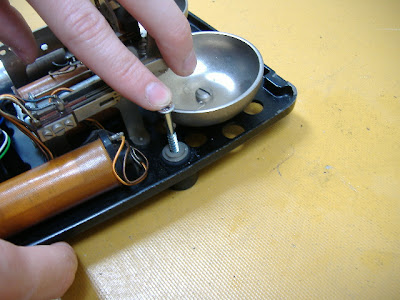Bakelite Telephones are regarded as Iconic pieces of British History and luckily they can often be restored to 99.9% of their former glory provide the Bakelite is not chipped or cracked.
Although Bakelite is a Brittle material, unlike modern plastics it is very resistant to ageing caused by acids pollutants and (UV) sunlight, making it extremely suitable for almost perfect restoration. You just need "lots" of patience and the know how.
This 60 year old 1953 British Bakelite Telephone (Model Number 314) was restored form its original state, see photograph of this vintage telephone below.
Above Fully Restored vintage 314 Phone, Below the same Bakelite GPO Telephone before the restoration process started.
The Bakelite Telephone Restoration process can be broken down into three main areas.
- Cleaning and Polishing Materials, such as Bakelite Polish etc, this is 10% of the total process. Paste polishing No 5 was originally used by the GPO back in the 1950's and in our opinion it is still the best Bakelite polish on the market. Luckily it is still available directly from the manufacturer Greygate Chemicals
- Elbow Grease (Physical Effort), this is 40% of the process. However, if you have access to the correct "slow speed" workbench buffing machine this will help speed up the restoration process and provide a much better final finish.
- Time and Patience = 50% of the process. For example the restoration of the Bakelite Telephone above took 9.5 hours of work over a three day time period. Even with the right tools, experience and compounds you are looking at a minimum of 9 hours to restore a Bakelite phone to this kind of near perfect condition.
Below are close up photographs of the vintage telephone restoration in detail. See if you can figure out which ones are the vintage telephone before restoration and which are the ones of the Bakelite phone after restoration :-)
Front View of the vintage Bakelite GPO 314 Telephone, with the rare extra 3 chrome buttons.
The Bakelite Telephone Handset, before and after restoration.
See how shiny and "near perfect" the right side of this beautiful
Vintage GPO Telephone looks after restoration.
The Classic horn shaped (model no164) Bakelite telephone mouthpiece.
Rear view of the vintage telephone. Notice the lovely reflection in the restored Bakelite.
NO paints, coloured polishes or varnishes were used, the Restored Bakelite telephone is just that. The only extra /new parts used in the above restoration were:
- High Quality British made cotton Braided Handset Cord.
- Metal 314 Badge (Bell On, Call Exchange, Bell Off)
- Replacement Dial Number plate (Very high quality, made in the UK).
We hope this helps or encourages people to restore these iconic antique/vintage GPO telephones. Remember lots of patience is the key.































